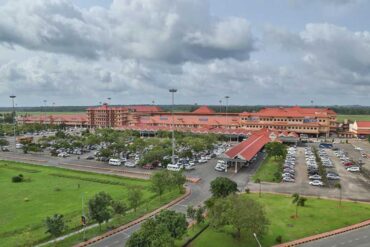Less than half a kilometre from the Kerala Irrigation department’s office at Ambattupalayam, in Chittur Taluk of Palakkad district, lies the plague house, a vestige of a bygone era. The idea of isolation, social distancing and quarantine is nothing new to the plague house. The weather-beaten plague house has survived the vagaries of nature for nearly a century. Getting a closer look at the building that has been invaded by weeds is nothing but an adventurous task and there is every chance that you might encounter snakes and insects in the process.
The house is believed to have been erected a century back by the architects of the Kingdom of Cochin. The inside of the house has no power but you will get to see the house filled with cobwebs in daylight.
 The plague that spread rapidly during the 1940s resulted in panic among the natives of the Kingdom of Cochin. “My house and my agricultural land are located near the plague house. I was studying in Class V then. We were scared to commute to school through the plague house premises as our parents used to warn us about getting infected by the plague,” remembers Ex-MLA, K A Chandran. The victims were transferred to Karukamani in Chittur, as the territory wasn’t contiguous to the rest of the Kingdom of Cochin and encircled by British Malabar. “The plague victims under the government including jail inmates were sent to the plague house here. It was heavily guarded by police with guns,” Chandran adds.
The plague that spread rapidly during the 1940s resulted in panic among the natives of the Kingdom of Cochin. “My house and my agricultural land are located near the plague house. I was studying in Class V then. We were scared to commute to school through the plague house premises as our parents used to warn us about getting infected by the plague,” remembers Ex-MLA, K A Chandran. The victims were transferred to Karukamani in Chittur, as the territory wasn’t contiguous to the rest of the Kingdom of Cochin and encircled by British Malabar. “The plague victims under the government including jail inmates were sent to the plague house here. It was heavily guarded by police with guns,” Chandran adds.
The jail inmates were protected till their death and were buried near Chitturpuzha (Chittur River), a kilometre away from the plague house. The bodies to be buried were tied to bamboo poles. The carriers of the body would be drunk and they would make loud sounds to stop people from coming near them.” I have recollections of men carrying bodies of the dead from the plague house to the burial place near Chitturpuzha with loud noises. The sound frightened us and stopped us from going anywhere close to the body,” says Chandran.
The plague house premises were safeguarded using a fence to avoid human entry. The interior of the house had only minimal facilities. The house didn’t have proper ventilation and that was added only later, when the irrigation department employees began to use it as a shelter.
When the Chitturpuzha project was on, the property was handed over to the Irrigation department. The plague house served as quarters for the employees of the irrigation department. Later the building was abandoned when the story of the plague came into limelight. “A few years back, a sweeper who worked on a contract basis used to stay in the plague house. But the building has been closed for around two years now,” said a government staff staying adjacent to the plague house.
Today, the plague house, a testament to the history of survival and the efficiency of isolation in the Kingdom of Cochin, is left to destruction. The building has been invaded by weeds and is in ruins.







